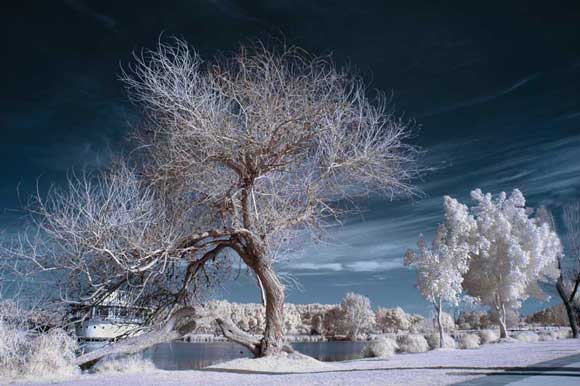How To Shoot Infrared – Infrared Photography Equipment
Cameras to Consider
Fujifilm IS-1
Based on the popular bridge camera, the FinePix 9600, the nine-million-pixel sensor in the IS-1 records both visible and infrared light. Designed for forensic and scientific uses, it includes an integrated 28-300mm equivalent zoom lens and flash, allowing full control and Raw file shooting.
Fujifilm IS Pro
The IS Pro is a modified version of the Fujifilm S5 Pro DSLR and offers an extended range of light sensitivity that spans into both ultraviolet (UV) and infrared (IR) wavelengths, covering roughly 380nm to 1000nm. This is a tool designed mainly for professional scientific use and the relatively high price for this model may put off amateur users.
Canon EOS 20Da
(RRP in 2005) This variation on the popular EOS 20D was released back in 2005 specifically for astro-photography. The removal of the low pass filter increased the transmission of light at the wavelength 656nm to improve capture of astronomical features such as the reddish nebulae, though, according to Canon, not the wider IR wavelengths. The technology in this camera is now looking pretty old, and astro models are hard to get hold of.
Sigma SD14
Even if you’ve never considered one of Sigma’s DSLR bodies before, you may be interested to know that this, now budget-priced, model has its IR filter mounted at the front of the lens mount that can be easily removed and replaced by hand – without the use of tools or risk of invalidating the warranty. The SD14’s Foveon X3 sensor is also great for tonal range, so for little more than the price of an infrared conversion you can have a shiny new camera, IR ready, in your camera bag. For best results use it with the ultra-wide Sigma 10-20mm f/4-5.6 (£399).
Accessories
If you’re using an infrared filter on your lens you’ll need a much slower exposure. It’s not uncommon to have shutter speeds of over eight seconds, so handholding is out of the question. To ensure a sharp shot make sure you have a good steady tripod, and that the legs and adjustments are locked tight before shooting. Using a remote release removes the risk of any movementwhen pressing the shutter, so is a worthwhile investment too.
Hoya / Tiffen
From £25 Filters are the traditional and still easiest way to achieve infrared effects. Placed in front of the lens they block out all but infrared wavelengths, to achieve a pure IR image. For best results you’ll still need a camera without a infrared-blocking filter on the sensor, such as the dedicated models, the Sigma SD14, or a converted model. Once the filter is on the lens you won’t be able to see through the viewfinder, so you’ll need to compose first.
Hoya R72
£25 This is the filter of choice for
most infrared shooters. It’s cheap, with prices starting at just £25
for the 52mm, and it delivers impressive results. However, as it allows
light with wavelengths from 720nm some claim it’s not a true infrared
filter and you should use the more extreme R90 (starting at 900nm) but
this requires even longer exposure times.
Tiffen 87
£75 The Tiffen 87 filter claims total
visible light absorption – only letting infrared through – and comes in
a range of sizes from 49mm to 77mm threads. Prices for this filter are,
however, significantly higher than the Hoya R72.
Manfrotto 190XProB
£82.50 (plus head) The 190 is a sturdy and affordable series of tripods that have recently been redesigned to allow the centre column to be swung round into a horizontal position without the need to dismantle or remove it first. Add the 486RC2 ball head (£43) for a perfect combination.
Hama Remote
£20 This simple wired remote offers an affordable alternative to manufacturers’ own brand models and comes in fittings for almost every DSLR. It features a two-stage press for focusing and shutter release and can be locked down for long bulb exposures.





